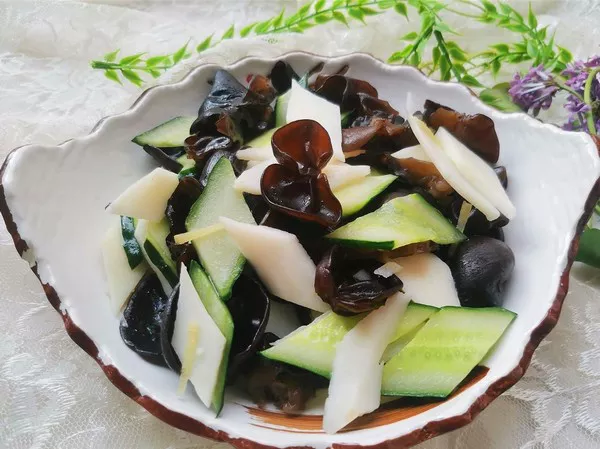Chinese yam, scientifically known as Dioscorea opposita, is a versatile and nutritious root vegetable that has been cherished in traditional Chinese cuisine and herbal medicine for centuries. With its mild, slightly sweet flavor and numerous health benefits, Chinese yam has found its way into a variety of dishes, both savory and sweet. In this comprehensive guide, we will explore the world of Chinese yam, from its selection and preparation to cooking techniques and the remarkable health advantages it offers.
Chinese Yam: A Brief Overview
Chinese yam, scientifically known as Dioscorea opposita, is a type of yam that belongs to the Dioscoreaceae family. It is native to China and other parts of East Asia. Chinese yam is a vine plant with heart-shaped leaves and produces tuberous roots that are the edible part of the plant. These tubers vary in size, shape, and color, but they generally have a cylindrical form with pale to light brown skin and creamy flesh.
The flavor of Chinese yam is mild and slightly sweet, making it a versatile ingredient that can be used in both sweet and savory dishes. It is known for its starchy and mucilaginous texture, which becomes soft and tender when cooked.
Selecting the Perfect Chinese Yam
Before you begin your culinary adventure with Chinese yam, it’s essential to choose the right yams for your dishes. Here are some guidelines for selecting the perfect Chinese yam:
1. Varieties of Chinese Yam
There are several varieties of Chinese yam, each with its unique characteristics. The most common ones include:
Common Chinese Yam (Dioscorea opposita): This is the standard variety with cylindrical tubers and pale skin.
Dioscorea opposita var. Stenophylla: These yams have slender, elongated tubers and are often used in herbal medicine.
Dioscorea opposita var. Alata: Known as the “purple yam,” this variety has dark purple skin and is used in both sweet and savory dishes.
2. Choosing Fresh and Quality Yams
When selecting Chinese yams, follow these tips to ensure freshness and quality:
Firmness: Choose yams that are firm to the touch, without any soft spots or spongy areas.
Skin: Look for yams with smooth, unblemished skin. Avoid yams with cracks or wrinkles.
Color: Chinese yams should have a uniform color. Variations in color can indicate age or damage.
Size: Opt for yams that are of medium size, as they tend to have a better texture and flavor.
Weight: Yams should feel heavy for their size, which indicates a good moisture content.
Aroma: While fresh yams don’t have a strong scent, they should not emit any unpleasant odors.
Preparing Chinese Yam for Cooking
Preparing Chinese yam for cooking is a straightforward process, but it’s essential to follow the right steps to maximize its flavor and texture.
1. Peeling and Cleaning
Wash the Yams: Start by rinsing the yams under cold running water to remove any dirt or debris from the skin.
Peel the Skin: Use a vegetable peeler or a paring knife to remove the skin from the yams. The skin is edible but is often removed for a smoother texture in dishes.
Cut into Desired Shapes: Depending on your recipe, you can cut the yams into slices, chunks, or thin strips. The shape you choose will influence the cooking method and presentation of your dish.
2. Cutting and Slicing
When cutting Chinese yam, consider the following tips:
Uniformity: For even cooking, try to cut the yam pieces into uniform sizes.
Thickness: The thickness of the slices or chunks can vary depending on the dish. Thicker cuts are ideal for roasting or stir-frying, while thinner slices work well in soups and stews.
Rinsing: After cutting, rinse the yam pieces under cold water to remove any excess starch that can make them stick together.
Cooking Techniques for Chinese Yam
Chinese yam can be prepared using various cooking techniques, each of which brings out its unique flavor and texture. Here are some common methods for cooking Chinese yam:
1. Boiling
Method: Place the yam pieces in a pot of boiling water and cook until they become tender. This method is often used for making congee (porridge) or for preparing yam for other dishes.
Texture: Boiling Chinese yam results in a soft and slightly gooey texture, ideal for soups and porridges.
2. Steaming
Method: Steam the yam pieces in a steamer until they are fork-tender. Steaming is a gentle cooking method that preserves the yam’s natural sweetness.
Texture: Steamed Chinese yam retains its shape and has a slightly firmer texture compared to boiling.
3. Roasting and Baking
Method: Toss yam chunks or slices with oil and seasonings, then roast or bake them until they turn golden brown and crispy. This method is excellent for creating yam fries or roasted yam dishes.
Texture: Roasted or baked Chinese yam has a crisp exterior and a creamy interior, offering a delightful contrast in textures.
4. Stir-Frying
Method: Heat a wok or skillet, add oil and stir-fry yam slices or chunks with other ingredients like vegetables, garlic, and soy sauce. Stir-frying adds depth of flavor and a savory touch.
Texture: Stir-fried Chinese yam is tender on the inside with a slightly crispy exterior.
5. Soup and Stew
Method: Chinese yam is a popular addition to soups and stews. It is added to the simmering liquid along with other ingredients to infuse the dish with its mild flavor.
Texture: In soups and stews, Chinese yam absorbs the flavors of the broth while maintaining a soft, comforting texture.
Delicious Chinese Yam Recipes
Now that you’ve learned how to select, prepare, and cook Chinese yam, it’s time to put your culinary skills to the test with some delightful recipes:
1. Stir-Fried Chinese Yam with Vegetables
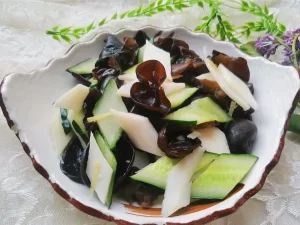
Ingredients:
- 1 Chinese yam, peeled and sliced
- 1 cup broccoli florets
- 1 carrot, sliced into thin strips
- 2 cloves garlic, minced
- 2 tablespoons vegetable oil
- 2 tablespoons soy sauce
- 1 teaspoon sesame oil
- Salt and pepper to taste
- Chopped scallions for garnish
Instructions:
Heat the vegetable oil in a wok or skillet over medium-high heat.
Add the minced garlic and stir-fry for about 30 seconds until fragrant.
Add the sliced Chinese yam and stir-fry for 2-3 minutes until they begin to soften.
Add the broccoli florets and carrot strips and continue stir-frying for another 3-4 minutes until the vegetables are tender-crisp.
Drizzle in the soy sauce and sesame oil, and toss to combine. Season with salt and pepper to taste.
Stir-fry for an additional 2 minutes until everything is well coated and heated through.
Garnish with chopped scallions and serve hot.
2. Chinese Yam Congee (Porridge)
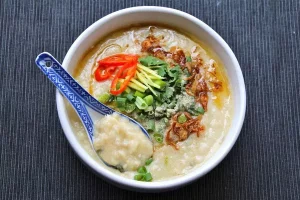
Ingredients:
- 1/2 cup rice
- 1 Chinese yam, peeled and diced
- 6 cups water or chicken broth
- Salt to taste
- Optional toppings: sliced green onions, fried shallots, sesame oil, and soy sauce
Instructions:
Rinse the rice under cold water until the water runs clear.
In a large pot, combine the rinsed rice, diced Chinese yam, and water or chicken broth.
Bring the mixture to a boil, then reduce the heat to low and simmer, covered, for 45-60 minutes, stirring occasionally, until the rice and yam are soft and the congee has thickened.
Season with salt to taste.
Serve hot with your choice of toppings, such as sliced green onions, fried shallots, a drizzle of sesame oil, and a splash of soy sauce.
3. Baked Chinese Yam Fries
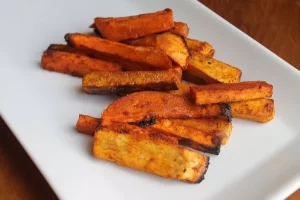
Ingredients:
- 2 Chinese yams, peeled and cut into fry-sized sticks
- 2 tablespoons olive oil
- 1/2 teaspoon paprika
- 1/2 teaspoon garlic powder
- 1/2 teaspoon onion powder
- Salt and pepper to taste
- Optional dip: Greek yogurt mixed with chopped fresh herbs and a squeeze of lemon juice
Instructions:
Preheat your oven to 425°F (220°C) and line a baking sheet with parchment paper.
In a large bowl, combine the Chinese yam sticks, olive oil, paprika, garlic powder, onion powder, salt, and pepper. Toss until the yam sticks are evenly coated with the seasonings.
Spread the seasoned yam sticks in a single layer on the prepared baking sheet.
Bake for 20-25 minutes, flipping the yam fries halfway through, until they are golden brown and crispy.
Serve hot with the optional yogurt dip.
4. Chinese Yam and Pork Soup
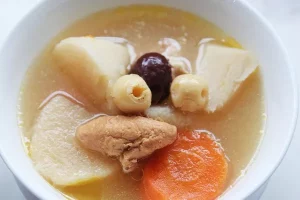
Ingredients:
- 1 Chinese yam, peeled and diced
- 1/2 pound pork loin or pork belly, sliced into thin strips
- 6 cups water or chicken broth
- 2 slices ginger
- Salt and white pepper to taste
- Chopped cilantro for garnish
Instructions:
In a large pot, bring the water or chicken broth to a boil.
Add the diced Chinese yam, sliced pork, and ginger slices to the boiling liquid.
Reduce the heat to low and simmer, covered, for 30-40 minutes, or until the yam is soft and the pork is tender.
Season the soup with salt and white pepper to taste.
Ladle the soup into bowls, garnish with chopped cilantro, and serve hot.
5. Chinese Yam Dessert
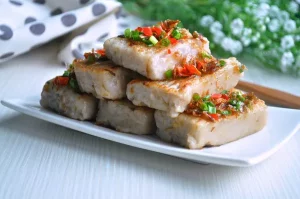
Ingredients:
- 1 Chinese yam, peeled and diced
- 2 tablespoons honey
- 1/2 teaspoon cinnamon
- 1/4 teaspoon nutmeg
- 1/4 cup chopped walnuts (optional)
- Vanilla ice cream or yogurt for serving
Instructions:
Preheat your oven to 375°F (190°C).
In a mixing bowl, combine the diced Chinese yam, honey, cinnamon, nutmeg, and chopped walnuts (if using). Toss until the yam is coated with the honey and spices.
Spread the mixture on a baking sheet in a single layer.
Bake for 20-25 minutes, or until the yam is tender and caramelized.
Serve the baked Chinese yam as a dessert, either on its own or with a scoop of vanilla ice cream or a dollop of yogurt.
Health Benefits of Chinese Yam
Beyond its culinary versatility, Chinese yam offers an array of health benefits that have been recognized in both traditional Chinese medicine and modern nutrition. Here’s a closer look at the nutritional profile and potential health advantages of Chinese yam:
1. Nutritional Profile
Chinese yam is a nutrient-rich root vegetable that provides essential vitamins, minerals, and dietary fiber. A 100-gram serving of raw Chinese yam typically contains:
Calories: Approximately 82 calories.
Carbohydrates: About 20 grams, primarily in the form of starch and dietary fiber.
Protein: Around 1.5 grams.
Fat: Minimal, with less than 0.5 grams of fat.
Dietary Fiber: Approximately 1.7 grams, aiding in digestive health.
Vitamin C: A good source of vitamin C, which supports immune function and skin health.
Vitamin B6: Essential for energy metabolism and brain health.
Potassium: An important mineral for maintaining blood pressure and fluid balance.
Manganese: Necessary for bone health and metabolism.
Dioscin and Allantoin: Compounds found in Chinese yam that are associated with potential health benefits.
2. Medicinal Uses and Traditional Chinese Medicine
In traditional Chinese medicine (TCM), Chinese yam is considered a valuable herb with various therapeutic properties. It is often used to support the spleen and stomach, nourish the lungs and kidneys, and promote overall vitality. Some of the key traditional uses of Chinese yam include:
Tonifying Qi: Chinese yam is believed to enhance the body’s vital energy, known as Qi, and strengthen the spleen and stomach, which are central to digestion and energy production.
Nourishing Yin: It is used to nourish Yin energy in the body, helping to balance Yang energy and maintain overall harmony.
Supporting Lung and Kidney Health: Chinese yam is thought to benefit the lungs and kidneys, promoting respiratory health and aiding in the management of conditions like dry coughs and urinary issues.
Enhancing Digestion: It is often used to improve digestion, alleviate diarrhea, and support overall digestive health.
Replenishing Essence: In TCM, it is believed to replenish Jing, which is considered the essence of life, supporting vitality and longevity.
3. Modern Health Insights
Modern research has shed light on some of the potential health benefits of Chinese yam, which align with its traditional uses. While further studies are needed to fully understand its mechanisms and efficacy, Chinese yam has shown promise in several areas:
Antioxidant Properties: Chinese yam contains antioxidants that may help protect cells from oxidative stress and inflammation.
Blood Sugar Control: Some studies suggest that Chinese yam may have a role in improving insulin sensitivity and regulating blood sugar levels.
Anti-Inflammatory Effects: Chinese yam extracts have demonstrated anti-inflammatory properties, which could have implications for managing inflammatory conditions.
Immune Support: The vitamin C content in Chinese yam may contribute to its immune-boosting potential.
Gastrointestinal Health: Chinese yam’s fiber content may aid in digestive health and alleviate symptoms of diarrhea and other gastrointestinal issues.
Conclusion
Chinese yam, with its mild flavor, versatile culinary applications, and potential health benefits, is a valuable addition to your kitchen and diet. Whether you’re enjoying it in savory dishes like stir-fries and soups or savoring its natural sweetness in desserts, Chinese yam offers a delightful culinary journey.
As you explore the world of Chinese yam, remember to select fresh and quality yams, follow proper preparation techniques, and experiment with various cooking methods to discover your favorite recipes. Whether you’re drawn to its traditional uses in Chinese medicine or its potential health advantages, Chinese yam has earned its place as a nourishing and delicious ingredient in both traditional and modern cuisines. Embrace the versatility of this root vegetable, and savor the wholesome flavors it brings to your table.

